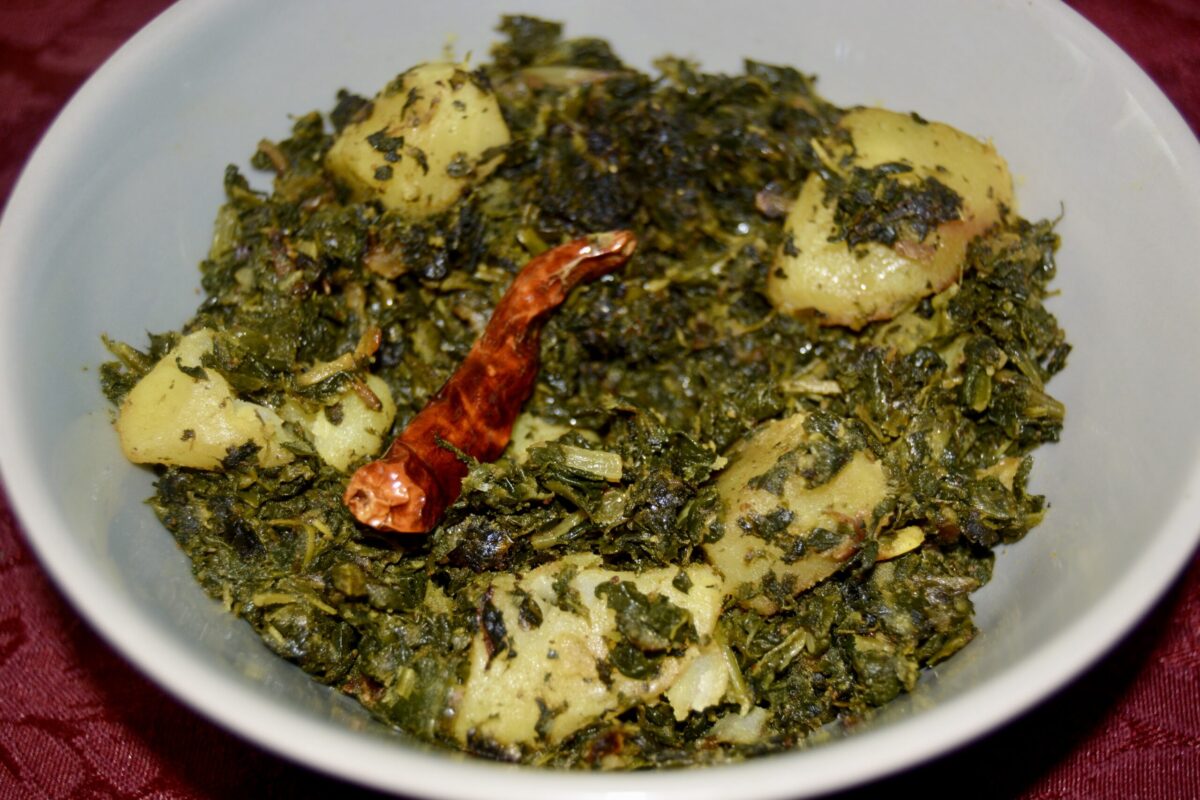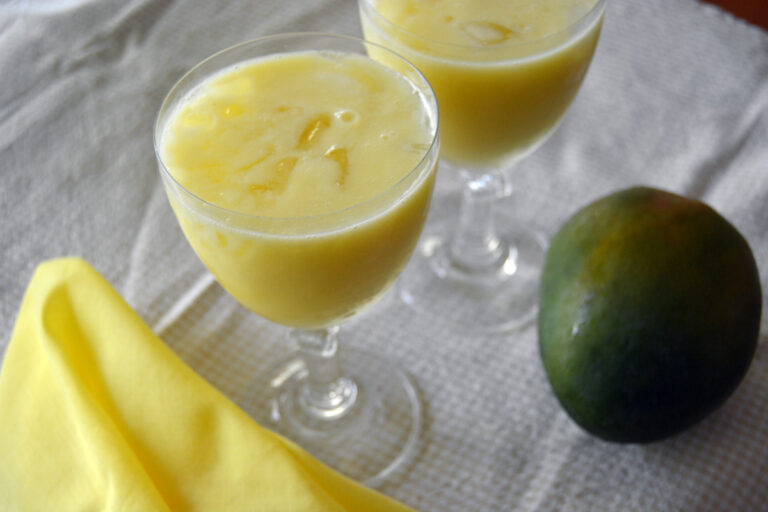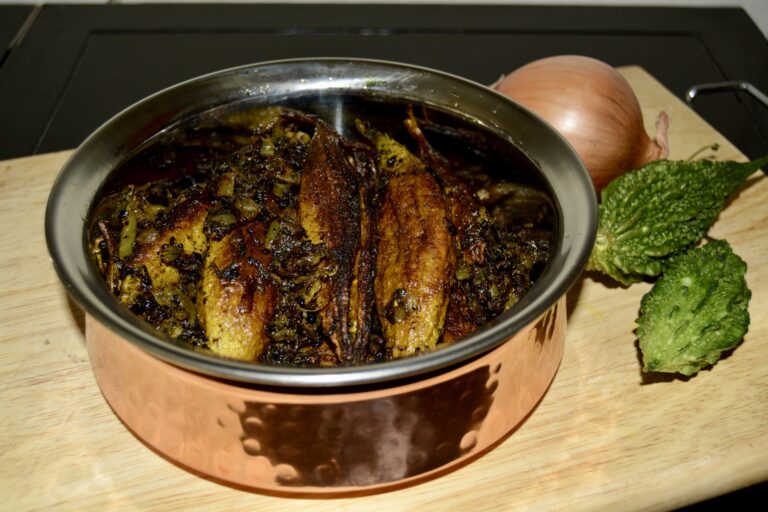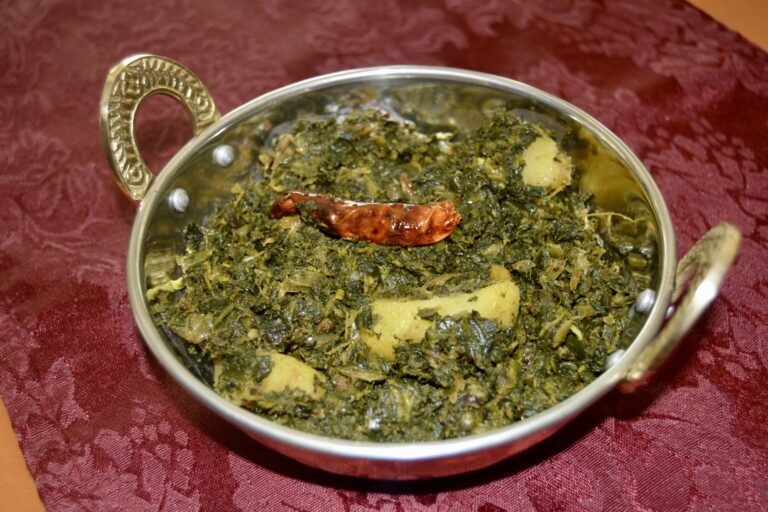My small kitchen garden has been bountiful this year, and the eggplants have been in abundance. I decide I will fix Baingan Bharta. The first time I tried to fix it was as a newlywed. Chachaji (my husband’s Uncle) and his wife (chachiji) were coming over for dinner. Not to digress, but in India, each family relationship is defined with a different term. Chacha refers to your dad’s younger brother, and his wife is called chachi. Ji is added out of respect.
Anyway, I decided to fix the dish from a recipe. The recipe called for large chunks of onions and tomatoes, which changed the flavor and texture of the traditional bharta. Chachaji and Chachiji were gracious enough not to comment on my initial culinary attempt!!
Our son was not much of a bharta fan. He never ate it at home, no matter how much I tried to persuade him to taste it. Then, on a visit to a friend in the neighborhood, he was forced (Indians don’t take no for an answer when it comes to eating!) to stay for dinner. Low and behold, there was the dreaded bharta on the table! He said he did his best to look like he was enjoying it, but concentrated on the dal!! We laugh at the memory. He still dodges it to this day.
Bharta tastes good with rice or roti. It also makes a good filling for a toasted sandwich or as a dip with corn chips.
But you have to like eggplant, of course!

Baingan Bharta (Roasted Mashed Eggplant)
Ingredients
- 2 large eggplants (I prefer the Black Beauty variety—large oval shaped ones)
- 2 large onions (finely chopped)
- 4 medium tomatoes (diced)
- 1 tsp cumin powder
- ½ tsp chili powder (or to your taste)
- ¼ tsp garam masala (optional)
- 1 Serrano chili (finely chopped, optional)
- 2 tbsp fresh cilantro (finely chopped)
- 4 tbsp cooking oil
- ¾ tsp salt
Instructions
To Prepare
- Wash the eggplants and wipe them dry. Char them over a gas burner, broiler, or barbecue. Turn frequently and cook till the outer skin is charred, and the inside is cooked. About 25-30 minutes. The eggplant will collapse and get soft. This method gives it a wonderful earthy, smoky flavor.
To Cook
- On medium heat, heat oil in a wok or deep dish skillet. Add the chopped chili, give it a minute or two for the oil to be infused with the chili heat, add your onions, and sauté for 5-8 minutes until half-brown.
- Add the spice powders (and the garam masala if you use it). Stir a few times.
- Now add the tomatoes. Stir till all the ingredients are nicely blended. Approximately 3-4 minutes.
- Add the eggplant pulp and mix it well into the onion and tomato mixture. Cover and cook for 7-8 minutes, stirring occasionally.
- Uncover and add the fresh cilantro and garam masala. Cook uncovered, stirring a few times, until the oil surfaces on the sides. About 2-3 minutes. I usually add a tablespoon of desi ghee at this point, but you could add butter if you do not have desi ghee handy.
- Turn off and let sit 5 minutes before transferring to a serving dish. Garnish with chopped cilantro.
- Tastes good with roti, rice, in a sandwich, or even a dip with toasted bread triangles, wheat thins, or corn chips.
Notes
The Dhungar Method: Take a small metal bowl and place it in the middle of the bharta in your serving dish. You can put a piece of aluminum foil under the bowl. Heat a small amount of coal until it fumes and flames. Put it into the metal bowl and pour a teaspoon of ghee over it. Cover the dish quickly. Leave it for about 5 minutes, and then remove the lid. Stir the bhurta and garnish with chopped cilantro leaves. I did try to use Liquid smoke once, but I'll leave that story for another time! Maybe it was the Hickory flavor. I probably will have better luck if I use a pure smoke flavor.
While in the military, Dad was transferred to Dehradun, set at the foot of the incredible Himalayas ranges. The large old colonial home we lived in for several years was spread over 3 acres. We had an abundance of mango and other fruit trees—and great adventures!
As kids, we enjoyed a whole lot of climbing trees and playing Tarzan. Dad even had a hen house built, and with domestic help, raised Rhode Island red hens and Leghorns. The hired help who lived on the premises took care of it all, so it was a breeze for our family. The house had stables and beautiful stalls. During colonial times, the British must have housed their horses and carriages there. Since the horse and buggy days were over, Dad decided to get a cow and Indian buffalo in place of horses.
There was always milk in abundance, and when the mangos were still raw, I remember Mom would make delicious Mango Fool during the hot summer season. Our house was always a magnet for the kids around the block, so she always had an enamel bucket of mango fool ready for us when we got hot and thirsty.
Now, looking back, I am amazed how Mom was able to feed the many!
A fool is a delicious combination of fruit and milk, but the Mango Fool Mom made was out of this world. It was a drink and not the usual dessert.

Mango Fool
Ingredients
- 6-8 medium raw mangoes (half raw will also do)
- ¾ cup sugar or to taste
- 3 cups water
- 3 cups chilled milk
- 1 cup crushed ice
Instructions
- Wash and peel the mangoes.
- Boil the peeled mangoes with water and sugar until they are tender. Approximately 20 minutes. Leave to cool.
- Squeeze out the pulp and discard the seed.
- Blend in an electric blender until smooth. If the mangoes you use have threads, strain them through a fine muslin cloth or mesh strainer.
- Chill the mixture until needed.
- When ready to serve, mix the mango mixture with the chilled milk.
- If it tastes too tart, add more sugar or milk to your taste.
- If the mangoes are starting to ripen, they should be sweet enough.
- Pour a quarter cup of crushed ice into tall glasses. Pour the mango fool in and serve with a sprig of fresh mint.
- A cool and refreshing drink for summer!
Notes
We are visiting my mother-in-law. Sitting on the large top floor balcony, we are enjoying cups of hot chai in the early morning cool. The house used to be a single-level home but when my mother-in-law retired, Mummy built a complete top floor with its own entrance where she lives. The first floor apartment is rented out to a family and our son is busy downstairs playing with their kids.
The vegetable vendor is passing by on the street alongside the house. He walks a few steps yelling “Karela, gobi, allu, bhindi, etc.,” to entice the housewives to purchase the vegetables. Mummy calls to the vendor, he enters the premises, right under the balcony, so she can spot-check all the veggies on the cart.
Finally, the vegetables are selected and a round of bargaining ensues until both of them are satisfied. Then, to our amusement, my mother-in-law lowers a basket attached to a rope down to the vendor. He puts the vegetables in, she draws it up and sends the money down for payment. We are awed by her ingenuity!
“See” she says, “now I can make your favorite karela.” She hands them to me, so I can go scrub and wash them. We both sit outside and prep the karela to cook later.
The Indian variety is smaller, more pointed and ridged than the Chinese variety. For this recipe, I prefer the Indian variety.

Karela Sabzi (Spiced Bitter Gourd)
Ingredients
- 12 small karela (choose the smaller, thinner ones)
- 1 tsp salt
- ½ tsp red chili powder (or to taste)
- 1 tsp cumin powder
- ¼ tsp tumeric (optional)
- ¼ tsp garam masala
- 2 medium onions (diced)
- ¼ cup cooking oil
Instructions
To Prepare Karela
- Scrub the karela with a brush. Pat dry, then scrape and save the top ridged skin (chilka) in a utensil.
- When the skin has been nicely scraped off, salt the karela and the skins separately (about 1 teaspoon of salt, each) and set aside for at least one hour. The longer it brines, the less bitter it will taste.
- After an hour, squeeze as much of the juice out of both the karela and the skins.
- Save the juice, dilute with water and drink it. It is a good blood purifier and help slower blood sugar–but it tastes awfully bitter!!
To Cook
- Slit the brined karela through the middle on one side and remove any hard seeds.
- Dice the onions, but not too finely.
- Heat oil in a large wok or heavy bottomed pan. Add in the karela carefully to avoid spluttering. It might be a good idea to use a splatter guard. Sauté until nicely dark brown all over. You will have to stir them from time to time. This should take about 10 mins.
- Set aside the sautéed karela on a paper towel to drain the excess oil.
- In the remaining oil in the pan (add a little more if you have to), add the karela skins and sauté till nicely browned.
- Add the chopped onions and stir-fry for another 5-8 minutes.
- Now mix in the fried karela and masalas and let them cook together for another 2-3 minutes. Taste for salt, although I doubt you will need to add any—unless you are like me!! Stir a few more times, and you are done.
- Spoon into a dish, and it is ready to be served.
- Best eaten with rotis or as a side dish with rice and dal.
Sabzi vendor photo credit: Gert-Jan Stads / International Food Policy Research Institute

It is summer. Dad is stationed at Srinagar, Kashmir, and we are taking a road trip in a military transport to join him for our summer vacation. It is a long and arduous trip in the hot, sweltering heat across the northern plains of India. The canvas flaps on the sides of the truck are rolled up slightly to allow for some air.
Finally, we start to climb into the mountains. The air starts to get cooler. We climb higher. Now, it starts to really cool down. The two jawans (soldiers) escorting us on the trip pull down the canvas flaps, and tighten them all around, so the cold breeze is blocked. It is dusk. We reach the highest point of our journey which is a little township (if you can call it that) called Kud, and park outside the Dak bungalow (a government building, a relic from the British Raj used as rest houses).
We pile out of the truck. It is unexpectedly windy and freezing. We had not anticipated the cold and still have our jackets in the suitcases. Kud is a little over 6,000 feet in elevation, but the summer heat of the plains was still in our brain. The two younger siblings, shivering in their short cotton dresses, grab what they can of Mama’s sari palla (scarf portion of the sari), and try and wrap themselves in it. We, older ones, in our salwar and kurta, are slightly better off. A junior officer is waiting and hurries us into the Dak bungalow where a fire is burning in the marble fireplace in the drawing room. Oh, the bliss of thawing out! We are served hot chai and cookies.
Dinner is served within an hour. Allu Poori (or Allu Tak as we call it), accompanied by hot puffed pooris. It is delicious. The memory of it still stays with me.

Allu Poori (Curried Potatoes)
Ingredients
- 6 medium potatoes, boiled, peeled, and diced into bite sized cube
- ¼ cup yellow onions or shallots chopped fine
- 1 tsp fresh ginger chopped
- ¼ tsp chili powder or to taste
- ¼ tsp turmeric powder
- 1 tsp cumin powder (or ½ teaspoon cumin seeds)
- 2 tbsp tomato paste (or 3 fresh tomatoes chopped fine or puréed)
- 2-3 tbsp cooking oil
- 1 small or medium green chili (jalapeño), whole or chopped (optional)
- 3 cups hot water (approximately)
- 1 tsp salt or to your taste
- ¼ tsp garam masala (optional)
Instructions
- Heat oil in a deep skillet or wok. Toss in cumin seeds, stir for 30 seconds.
- Add the green chili and ginger, stir for 30 seconds.
- Add the onions and sauté for 3-5 minutes until they start to turn slightly brown.
- Add turmeric, chili, and cumin powders.
- Stir the powders for less than 30 seconds, and then add the tomato paste.
- Cook for about 2-3 minutes to get the raw taste of tomatoes out. If using fresh tomatoes, cook until they turn pulpy, approximately 10-15 mins.
- Now add the potatoes into the onion-tomato spice mixture and add approximately 3 cups of water.
- Add salt. Give the mixture a nice stir, then cover, and bring to a boil.
- Simmer for 10 minutes.
- Uncover and with the back of your spoon mash some of the potatoes up against the sides of the pan to get a thickish gravy.
- Monitor the water you add. The gravy has to be a thick gravy and not watery. If it gets too thick you can add more water, if too thin, uncover and cook until it thickens
- Turn off heat and let sit 5 -10 minutes.
- Pour into a serving dish and garnish with chopped cilantro and sprinkle with garam masala
- Serve with pooris, pita bread, tortillas or parathas. This dish goes well with any kind of flat bread.
Notes
Srinagar Photo by SOURAV BHADRA on Unsplash
Indians don’t generally eat spinach as a salad. It is almost always cooked into a sabzi, the most famous being Palak Paneer. It is also used in dal, parathas, or pakoras. Since I love potatoes, it usually gets incorporated into many of my sabzis. Adding potatoes to greens like spinach and fenugreek also helps in stretching the dish to feed unexpected, drop-in guests. Indians always welcome company, any time of the day.
I use fresh spinach when available, and, personally, I find that very little difference in taste when I use frozen spinach. The plus side to frozen spinach is that there is no tedious cleaning or chopping of the vegetable. Just defrost and go!
If you do go the fresh route, before you wash the spinach, keep the bundle intact, heads together and stalks together. Then chop off the extra long stalk and discard. Immerse the spinach in a deep bowl of water, then dip and immerse several times to get all the grit out. I change the water once. Now rinse it in a colander, moving it back and forth, or use your faucet spray if you have one. Drain and chop moderately fine.
If you’re using pre-washed spinach in a salad bag, just rinse it before you chop and cook it. I suggest this as I’ve found dirt in “pre-washed” leaves too many times!

Palak Allu Sabzi (Sautéed Spinach and Potatoes)
Ingredients
- 1 lb frozen chopped spinach (or fresh spinach, washed and chopped)
- 2 medium potatoes (peeled and quartered)
- ½ medium yellow onion (or 1 shallot, peeled and diced)
- 1 whole red chili pepper (optional, more or less to taste)
- ½ tsp tumeric powder
- 1 tsp cumin powder
- salt (to taste)
- 2 tbsp cooking oil
- 4 tbsp water (½ cup of water if you are using fresh spinach)
- 2 tsp desi ghee (clarified butter, optional)
- ¼ tsp garam masala (optional)
Instructions
- On medium heat, heat the oil in wok or skillet. Add the red chili (if you want a spicy taste) and chopped onion. Sauté till ¾ brown. Approximately 5-7 mins.
- Add the turmeric and cumin powder. Stir a few times, and then add the potatoes. Cook for about 5 minutes, stirring gently to coat the potatoes with masala.
- Add the spinach and salt, and then add just enough water to cook the potatoes. Turn the heat down, cover the pan, and cook on low for 5 minutes.
- Remove the lid and cook for another 7-8 minutes until the potatoes are cooked and the moisture has almost evaporated. Do not let it dry out.
- Once the potatoes are done, remove the skillet from the heat and sprinkle garam masala over the sabzi. Cover and let rest at least 5 minutes for the dish to absorb all the flavors.
- Serve with tortillas, rotis, or rice and as an accompaniment to any dal or curry.
Notes
Variations: You can also substitute baby red potatoes, scrubbed and halved or quartered, with skin on. A half cup of cooked Garbanzo beans (kabli channa) are very tasty mixed into the spinach, too. Omit the potatoes to fix a plain spinach sabzi. .
We are returning from our trip to Chandigarh to see my mother-in-law. The bus is crowded as usual, but my husband manages to get me a window seat, and then sits down next to me. My mother-in-law has packed us parathas, despite my polite protests. “No, no,” she admonishes. “You must always carry something with you, as you never can tell when you will get hungry.” I am a newlywed and dare not argue with her. She wraps the parathas in foil and adds some pickle in each. I add a bunch of napkins to the plastic bag she hands me. I am not sure how I am going to manage eating that on the ride home, but you don’t say no to your Indian mother-in-law!

Two hours into the ride, I am very grateful for her insistence. The bus driver has stopped at the next town, and the wayside vendors’ foods look seriously dubious. Quickly, I open the packed goodies, and we feast on the parathas. My husband brings hot chai and I happily sip on this delicious beverage as I munch on my parathas.
Parathas are similar to a sautéed tortilla, either plain or filled with spicy potato (allu), or you can make it out of cauliflower (phool gobi), or Diakon-Japanese radish (Moolee). The spices in the stuffing vary. They make a good brunch and vegan meal and are very filling.

Allu Paratha: Indian Potato Stuffed Bread
Ingredients
Filling
- Oil for sautéing the parathas (peanut oil, canola oil, or vegetable oil)
- 5-6 medium boiled potatoes (peeled and mashed)
- ½ tsp Amchoor powder (mango powder, available at any Indian grocery store)
- ½ tsp roasted Zeera powder (cumin powder) (optional)
- 1-2 green chilies, finely chopped (depending on how spicy you want your parathas to be!)
- ¼ tsp chili powder (optional, to taste)
- 1 small onion ( chopped very fine)
- 1 tbsp cilantro (finely chopped)
- salt to taste
Dough
- 3 cups Durham flour
- ¼ tsp salt
- 1 cup water to knead dough (you may need a bit more than 1 cup)
Instructions
- Sift flour and salt. Make a well in the center of sifted flour, then pour half the water in and mix. Continue to add water till the flour is moist and knead dough for about 10 minutes until it is soft and pliant and no longer sticky. You can knead dough in an electric mixer.
- Let rest for about half an hour to one hour.
- Roll out two golf-sized balls into 4" rounds. Place about 2 tbsp of mixture on one of the round flatbreads and spread evenly. Place the other rolled flatbread over it and pat down lightly making sure edges are sealed. Gently roll out to about 6" in diameter.
- Sprinkle a little dry flour on top in case it starts to stick while rolling.
Alternate Filling Method
- Take a slightly larger piece of dough and roll it into a ball. Now flatten it with your palms. Add a tablespoon or two of the potato mixture on the top center of the dough. Cover the mixture by pulling on the sides of the dough and press the dough together on the top so that you have a ball of dough with the potato in the center. Flatten this and roll it out like a tortilla.
To Cook
- Heat flat frying pan or Indian tava on medium heat. Place the rolled-out paratha on it, and cook until you start to see little bubbles on the top side. If the pan is hot enough, this takes about two minutes.
- Carefully flip the paratha over with a spatula, and cook the other side.
- Now pour about a teaspoon or more of oil on the top half of the paratha and spread it evenly.
- Flip the paratha over again and oil the other side the same way. Cook till golden brown on both sides.
- Serve warm with a dollop of butter on the paratha, and plain yogurt and pickle on the side.
Chandigarh Bus Photo via Chandigarh Transport Undertaking







